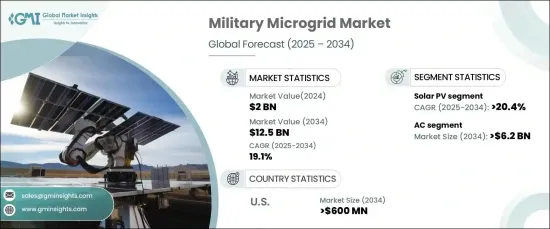
|
시장보고서
상품코드
1665060
군용 마이크로그리드 시장 기회, 성장 촉진요인, 산업 동향 분석 및 예측(2025-2034년)Military Microgrid Market Opportunity, Growth Drivers, Industry Trend Analysis, and Forecast 2025 - 2034 |
||||||
세계의 군용 마이크로그리드 시장 규모는 2024년에 20억 달러로 평가되었고 2025년부터 2034년까지의 CAGR은 19.1%로 큰 성장이 예측되고 있습니다.
군용 마이크로그리드는 독립 또는 주전원 네트워크와 함께 작동할 수 있는 혁신적인 국소 에너지 시스템입니다. 이러한 시스템은 중요한 방어 업무에 탄력성, 안전성, 신뢰성이 높은 에너지를 제공하며, 특히 원격지 및 비전화 장소에서 중단 없는 전력을 확보합니다. 신재생에너지원, 에너지저장 솔루션, 고급 제어를 통합함으로써 군용 마이크로그리드는 국방군이 도전 환경에서 에너지 신뢰성에 접근하는 방식을 재정의하고 있습니다.

송전망의 고장, 사이버 공격, 자연재해 등의 경우에 중요한 인프라를 유지하기 위해 지속적이고 신뢰할 수 있는 전력에 대한 요구가 높아지고 있는 것이 군용 마이크로그리드 시장의 확대를 뒷받침하고 있습니다. 이러한 시스템은 특히 연료 공급 라인이 중단될 수 있는 지역과 에너지 안보가 최우선으로 되는 고위험 환경에서 비용 효율성과 신뢰성을 평가합니다. 군용 마이크로그리드는 미션 크리티컬한 작업을 지원할 수 있을 뿐만 아니라 기존의 에너지원에 대한 의존도를 줄일 수 있기 때문에 방위 조직에서의 채용을 더욱 뒷받침하고 있습니다.
| 시장 범위 | |
|---|---|
| 시작 연도 | 2024년 |
| 예측 연도 | 2025-2034년 |
| 시작 금액 | 20억 달러 |
| 예측 금액 | 125억 달러 |
| CAGR | 19.1% |
그리드 유형별로 볼 때 군용 마이크로그리드 시장은 AC, DC, 하이브리드 시스템으로 구분됩니다. AC 그리드 부문은 기존 전기 인프라와의 호환성과 배전 효율로 2034년까지 시장 규모는 62억 달러에 달할 것으로 예상됩니다. AC 그리드는 장거리 전압 조정이 뛰어나 가혹한 조건에서 신뢰성이 입증되었으므로 안정적인 에너지 솔루션이 필요한 군사 용도에 적합합니다.
전원의 경우 시장에는 디젤 발전기, 천연 가스, 태양광 발전(PV), 열전병 공급(CHP) 시스템 등이 포함됩니다. 태양광 발전(PV) 분야는 2034년까지 연평균 복합 성장률(CAGR)이 20.4%로 가장 급성장할 것으로 예측되고 있습니다. 이 성장의 원동력이 되는 것은 풍부한 재생 가능 자원으로부터 지속 가능한 에너지를 생산하고 깨끗하고 경제적인 환경 친화적인 에너지 솔루션을 제공하는 태양광 발전입니다. 태양광 발전 시스템은 설치가 쉽고 배치가 빠르기 때문에 기존의 에너지원에서는 실현 불가능하고 실용적이지 않은 군사 작전에 특히 매력적입니다.
미국의 군용 마이크로그리드 시장은 에너지 회복력에 대한 투자 증가를 배경으로 2034년까지 6억 달러를 창출할 것으로 예측됩니다. 사이버 위협, 자연재해, 송전망 고장으로부터 중요한 업무를 보호할 필요성이 미국 시장 성장을 가속화하고 있습니다. 정부 기관은 보다 광범위한 에너지 안보 전략의 일환으로 마이크로그리드 프로젝트에 대한 자금 지원을 선호합니다. 이러한 노력은 미션 크리티컬한 업무가 기존의 전력망에 의존하지 않고 완전히 기능을 계속할 수 있도록 보장하기 때문에 군용 마이크로그리드는 국가 안보 인프라로서 필수적인 존재가 되고 있습니다.
목차
제1장 조사 방법과 조사 범위
- 시장의 정의
- 기본 추정과 계산
- 예측 계산
- 1차 조사와 검증
- 1차 정보
- 데이터 마이닝 소스
- 시장 정의
제2장 주요 요약
제3장 업계 인사이트
- 업계 에코시스템
- 규제 상황
- 업계에 미치는 영향요인
- 성장 촉진요인
- 업계의 잠재적 위험 및 과제
- 성장 가능성 분석
- Porter's Five Forces 분석
- 공급기업의 협상력
- 구매자의 협상력
- 신규 참가업체의 위협
- 대체품의 위협
- PESTEL 분석
제4장 경쟁 구도
- 서론
- 전략 대시보드
- 혁신과 지속가능성의 전망
제5장 시장 규모와 예측 : 연결성별(2021-2034년), 10억 달러
- 주요 동향
- 그리드 연결
- 오프 그리드
제6장 시장 규모와 예측 : 전원별(2021-2034년), 10억 달러
- 주요 동향
- 디젤 발전기
- 천연가스
- 태양광 발전
- CHP
- 기타
제7장 시장 규모와 예측 : 스토리지 장치별(2021-2034년), 10억 달러
- 주요 동향
- 리튬 이온
- 납축
- 플로우 배터리
- 플라이휠
- 기타
제8장 시장 규모와 예측 : 그리드 유형별(2021-2034년), 10억 달러
- 주요 동향
- 교류
- 직류
- 하이브리드
제9장 시장 규모와 예측 : 지역별(2021-2034년), 10억 달러
- 주요 동향
- 북미
- 미국
- 캐나다
- 멕시코
- 유럽
- 독일
- 프랑스
- 영국
- 러시아
- 스페인
- 이탈리아
- 덴마크
- 아시아태평양
- 중국
- 일본
- 한국
- 인도
- 호주
- 중동 및 아프리카
- 사우디아라비아
- 아랍에미리트(UAE)
- 남아프리카
제10장 기업 프로파일
- ABB
- Ameresco
- Caterpillar
- FlexGen Power Systems
- General Electric
- Piller Power Systems
- PG&E
- Saft
- Stellar Energy
- Schneider Electric
- Siemens
The Global Military Microgrid Market was valued at USD 2 billion in 2024 and is projected to experience significant growth, with a CAGR of 19.1% from 2025 to 2034. Military microgrids are innovative, localized energy systems capable of functioning independently or in conjunction with the main power grid. These systems provide resilient, secure, and reliable energy to critical defense operations, ensuring uninterrupted power, especially in remote or off-grid locations. By integrating renewable energy sources, energy storage solutions, and advanced controls, military microgrids are redefining how defense forces approach energy reliability in challenging environments.

The growing need for continuous, dependable power to sustain vital infrastructure during grid failures, cyberattacks, and natural disasters is driving the expansion of the military microgrid market. These systems have gained recognition for their cost-effectiveness and reliability, particularly in areas where fuel supply lines may be disrupted or in high-risk environments where energy security is paramount. Military microgrids are not only able to support mission-critical operations but also reduce reliance on traditional energy sources, further boosting their adoption among defense organizations.
| Market Scope | |
|---|---|
| Start Year | 2024 |
| Forecast Year | 2025-2034 |
| Start Value | $2 Billion |
| Forecast Value | $12.5 Billion |
| CAGR | 19.1% |
In terms of grid types, the military microgrid market is segmented into AC, DC, and hybrid systems. The AC grid segment is expected to generate USD 6.2 billion by 2034, driven by its compatibility with existing electrical infrastructure and its efficiency in power distribution. AC grids excel at voltage regulation over long distances, demonstrating proven reliability in extreme conditions, making them the preferred choice for military applications that require steadfast energy solutions.
When it comes to power sources, the market includes diesel generators, natural gas, solar photovoltaic (PV), combined heat and power (CHP) systems, and others. The solar PV segment is projected to experience the fastest growth, with a CAGR of 20.4% through 2034. This growth is fueled by solar PV's ability to produce sustainable energy from abundant renewable resources, offering a clean, affordable, and eco-friendly energy solution. The easy installation and rapid deployment of solar PV systems make them especially attractive for military operations, where conventional energy sources are not feasible or practical.
The U.S. military microgrid market is anticipated to generate USD 600 million by 2034, driven by increasing investments in energy resilience. The need to secure critical operations against cyber threats, natural disasters, and grid failures is accelerating market growth in the U.S. Government agencies are prioritizing funding for microgrid projects as part of their broader energy security strategies. These initiatives ensure that mission-critical operations can remain fully functional without relying on conventional power grids, making military microgrids a vital part of national security infrastructure.
Table of Contents
Chapter 1 Methodology & Scope
- 1.1 Market definitions
- 1.2 Base estimates & calculations
- 1.3 Forecast calculation
- 1.4 Primary research & validation
- 1.4.1 Primary sources
- 1.4.2 Data mining sources
- 1.5 Market definitions
Chapter 2 Executive Summary
- 2.1 Industry synopsis, 2021 – 2034
Chapter 3 Industry Insights
- 3.1 Industry ecosystem
- 3.2 Regulatory landscape
- 3.3 Industry impact forces
- 3.3.1 Growth drivers
- 3.3.2 Industry pitfalls & challenges
- 3.4 Growth potential analysis
- 3.5 Porter's analysis
- 3.5.1 Bargaining power of suppliers
- 3.5.2 Bargaining power of buyers
- 3.5.3 Threat of new entrants
- 3.5.4 Threat of substitutes
- 3.6 PESTEL analysis
Chapter 4 Competitive landscape, 2024
- 4.1 Introduction
- 4.2 Strategic dashboard
- 4.3 Innovation & sustainability landscape
Chapter 5 Market Size and Forecast, By Connectivity, 2021 – 2034 (USD Billion & MW)
- 5.1 Key trends
- 5.2 Grid connected
- 5.3 Off grid
Chapter 6 Market Size and Forecast, By Power Source, 2021 – 2034 (USD Billion & MW)
- 6.1 Key trends
- 6.2 Diesel generators
- 6.3 Natural gas
- 6.4 Solar PV
- 6.5 CHP
- 6.6 Others
Chapter 7 Market Size and Forecast, By Storage Device, 2021 – 2034 (USD Billion & MW)
- 7.1 Key trends
- 7.2 Lithium-ion
- 7.3 Lead acid
- 7.4 Flow battery
- 7.5 Flywheels
- 7.6 Others
Chapter 8 Market Size and Forecast, By Grid Type, 2021 – 2034 (USD Billion & MW)
- 8.1 Key trends
- 8.2 AC
- 8.3 DC
- 8.4 Hybrid
Chapter 9 Market Size and Forecast, By Region, 2021 – 2034 (USD Billion & MW)
- 9.1 Key trends
- 9.2 North America
- 9.2.1 U.S.
- 9.2.2 Canada
- 9.2.3 Mexico
- 9.3 Europe
- 9.3.1 Germany
- 9.3.2 France
- 9.3.3 UK
- 9.3.4 Russia
- 9.3.5 Spain
- 9.3.6 Italy
- 9.3.7 Denmark
- 9.4 Asia Pacific
- 9.4.1 China
- 9.4.2 Japan
- 9.4.3 South Korea
- 9.4.4 India
- 9.4.5 Australia
- 9.5 Middle East and Africa
- 9.5.1 Saudi Arabia
- 9.5.2 UAE
- 9.5.3 South Africa
Chapter 10 Company Profiles
- 10.1 ABB
- 10.2 Ameresco
- 10.3 Caterpillar
- 10.4 FlexGen Power Systems
- 10.5 General Electric
- 10.6 Piller Power Systems
- 10.7 PG&E
- 10.8 Saft
- 10.9 Stellar Energy
- 10.10 Schneider Electric
- 10.11 Siemens














